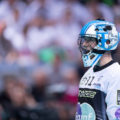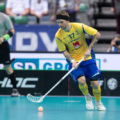The WFC of 2019 starts soon and here at FloorballToday we are busy with the preparations. What does this mean? Contacting players for interviews, looking at all the facts and figures of past editions and taking a deep dive into the history of floorball.
Note: there is no footage available from the first WFCs since we still hadn’t entered the age of digital photography. However, after some digging the Swedish Federation gave us the name of the photographer of the WFC1999. A massive thanks to Stefan Svensson to take all the effort to scan his pictures and sending it to us and make them available. If you need a photographer in Sweden, we really recommend checking him out.
Floorball as a pastime may have originated into the 70s but as a sport, it was established much later. One could argue that the foundation of floorball as a ‘proper’ sport was laid out in 1986 with the founding of the International Floorball Federation (IFF) but in this series of articles, we’ll be looking into another important part of our sport: the World Floorball Champions (WFC), specifically the Women WFCs, from the early days of 1997 and the two editions that followed.

Once upon a time
The first Women’s World Cup was held in May 1997 on the Finnish island of Åland and had two playing cities, namely the little Godby and the bigger Mariehamn. Åland is perhaps more Swedish than Finnish as the population mostly speaks Swedish so perhaps this ‘neutral’ territory between the two superpowers Finland and Sweden made sense diplomatically as the first Women WFC.
Ten countries participated in the tournament, with Japan being the only country that came from outside the (extended) European continent (and ended with a goal balance of 1-83). The tournament had a simple structure with two groups in which the number 1 of group A played against the number 2 of group B in a semi-final, which was followed by a finals. The champion of this first edition was none other than Sweden, who steamrolled their way through the group stage (with a 75-1 score) and who defeated Finland with 4-2 in the final.

1999
Perhaps having learned from the first WFC edition and its WFC-unworthy game results – for example, [ppp_non_patron_only]…
We reserved the rest of this article for those who support us monthly with a small donation. Will you be the next FloorballToday patron on Patreon? Join the community now! Click here for all the info.
[/ppp_non_patron_only][ppp_patron_only level=”6″ silent=”no”] 32-0 between Sweden and Austria in its opening game – the IFF opted for a slightly different set-up in edition 1999. From this edition onwards they divided the tournament into a completely separate A&B Division, which we see nowadays in a slightly altered form in the U19 WFC.

This time, the tournament was on Swedish soil. Where Sweden took the championship on Finnish land in 1997, this time the tables were turned and saw Finland victorious after the team dealt with Sweden in a nail-biting semifinal (2-3 after penalties). In the finals, Switzerland was placed aside with 3-1.

How come we haven’t mentioned the Czech Republic yet? After all, this country is part of what is now known as the TOP4. The reason is quite simple: the Czech Republic has fought its way up – impressively – to a TOP4 position in the past ten years (especially at the women’s level) but at the beginning of the century it was mainly Norway and Switzerland that could compete with the global top. Looking at Norway’s strength in this era, it is a surprise that the team never made it to a WFC final even once. In the group stage of WFC1999, for example, Finland and the Czech Republic were fairly simply set aside with 5-2 and 7-1.

Finland wins again
In 2001 it was again Finland that came knocking at the door and we could see a continuation of the TOP3 of dominating countries: Finland, Sweden and Norway. At least, if you looked at the group phase:

These countries were accompanied by dangerous outsider Switzerland who – as in earlier editions – may not have impressed during the group stages, but who did extremely well in the playoffs. This brought the country to the semi-finals in the previous edition and also in WFC2001 the team made it to the semi-finals, in which it narrowly lost to Finland. Also in this edition, Finland proved to be the strongest by pushing Sweden aside in the finals with 2-0.

So, that was it. The first three editions of the World Floorball Championships! Did you enjoy this article? Let us know in the comments!
Want to see more pictures from the WFC1999? Then check out the pictures on Patreon.
[/ppp_patron_only]







No Comments
Leave a comment Cancel